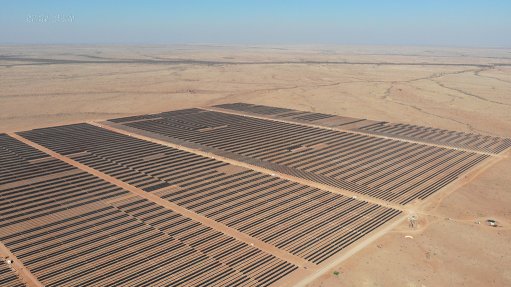New tech competitive this year – AngloGold

AngloGold Ashanti COO South Africa Mike O’Hare tells Mining Weekly Online’s Martin Creamer that the company’s new raise-boring technology will be competitive with conventional mining this year. Video: Nicholas Boyd. Video Editing: Lionel da Silva.
JOHANNESBURG (miningweekly.com) – The new raise-boring technology, which produced 100 kg of gold for AngloGold Ashanti in 2014, is targeted to be competitive with conventional mining this year.
Last year the company used the raise-bore technology to drill 83 holes in shaft pillars that are unsafe to mine conventionally.
So far, the technology has put the company in a position to mine “all the gold and only the gold all the time” and to overcome the current drill-and-blast constraint of only being able to work 66% of each day.
This has resulted in discussion being opened with the union at Tau Tona to embark on a programme of continuous mining.
AngloGold Ashanti COO South Africa Mike O’Hare outlines in the attached video produced by Creamer Media’s Mining Weekly Online that 2015 will see continued site development so that additional reef-boring machines can be installed, work cycle improvement and the facilitation of work taking place 365 days a year, 24 hours of the day.
“We certainly believe that we will be competitive with conventional mining during 2015,” O’Hare says.
A graphic on the technology progress indicates that both raise boring and ultra high strength backfill hurdles have been scaled, but that the company needs to develop a faster method of providing geological information and is only 55% of the way towards that, and that a compatible mechanical development methodology needs to be established, which is only 3% of the way.
However, the need for the new technology is compelling as only 60% of the gold ore in South Africa’s rich Witwatersrand basin is accessible using current drill-and-blast technology and 40% of the gold is left behind in pillars to keep seismicity at bay.
The current mining method then loses a further 25% to 30% of that 60% because blasting breaks the ore into so many pieces that not all of them can be recovered, particularly as fractured sizes range from fine powder to large boulders.
Once blasted, the product is moved up to seven times, which results in more losses.
On average, there is 200% more waste than gold in the mix moved and dilution can be as high as 1 500%, which means that huge volumes of nonpay material has to be transported out of ever-deepening cavities.
One hundred grams of gold in the ground becomes 30 g or 25 g of gold on surface, after getting out only 60% of what was there in the first place.
What is far worse is the death and injury rate, which remains in spite of the huge effort to achieve zero fatalities.
During the twentieth century alone, the Leon Commission calculated that 69 000 people were killed in South Africa’s mines and a million seriously injured, maimed or physically damaged.
Currently, safety has plateaued and, unless significant change is made to what creates this plateau, death and injury in mines will continue.
There is thus an absolute need to change if deep-level gold mining is to be sustainable – and AngloGold Ashanti is at the forefront of a move under senior VP: technology and projects Shaun Newberry to ensure sustainability.
The current mining method is clearly not the one that should take South Africa into the future. In fact, if it continues to be pursued, gold mining will end long before the Witwatersrand basin’s three-billion ounces of gold are extracted.
Some 1.7-billion ounces have been mined, only 200-million more ounces are in reserve and 1.1-billion ounces stand to be left in the ground unless a new mining technology is introduced.
Since 2010, AngloGold Ashanti has been working consistently to introduce a safer and more efficient way of mining narrow-reef orebodies and has developed and manufactured prototypes in a relatively short time.
The new technology involves boring holes of the required reef-channel width, collecting and transferring the bored chips in an enclosed system for further processing and backfilling the cavities to stabilise the underground environment and reduce seismicity.
In order to reach depths of 5 km and beyond, the rock mass removed needs to be replaced with similar material of 170 MPa compressive strength to prevent movement.
Each hole is sealed at the bottom access point and a high-viscosity mixed product is pumped to the top access point.
All this is already happening.
Steps are being taken to enable the reef-boring machines already in use to move and align themselves automatically on the basis of geological data.
Near-term work is also being undertaken to evolve towards a form of gold liberation using chemicals, thermal energy or other methods to free the gold for hydraulic transport back to surface and achieve the original vision of having gold on tap 24 hours a day, 365 days a year.
Knowledge of rock fragmentation is also an enabler for reef boring, as less power will be needed if better rock fragmentation methodology can be developed.
There are many such projects under way in the background because of their relationship with the programme’s first two stages.
But exponentially faster geological information will be needed to deploy the new technology.
To be able to bore the reef over distance, the location of the gold-bearing rock will have to be determined far more quickly and accurately.
Currently, there is nothing available that can provide the information at the pace needed and something suitable will have to be developed.
In the meantime, the quick win of shaft pillar mining is being seized upon, where such information is already available.
High-speed haulage-boring machines are needed to create the main infrastructure for logistics and geological drilling platforms as well as smaller-diameter access for on-reef infrastructure.
Once the on-reef grid has been established, the idea is for ventilation to be achieved by drilling holes between the drives using a raisebore machine.
It is envisaged that reef boring and ultra-high-strength backfilling can then take place from the drives.
Reef boring begins from the bottom reef drive using a machine set up on the lower of the two levels to be connected.
Line boring is used to drill a hole from the lower level to the upper level and is then backfilled on completion.
The completed hole has smooth walls and does not require support.
The vision is of mechanical mining being remotely controlled from safe areas and extraction ratios being boosted by a new mining methodology and backfilling of cavities with material as hard as the rock itself.
Targeted are significant portions of orebody currently left behind and the elimination of gold loss down microcracks.
Instead, the plan is to transport consistent smaller chips from the rockface to the mill in one enclosed system.
The technology is said to have the potential to increase the extraction ratio from the current 60% to 70% to at least 80% to 90% and will help solve the high closure challenge expected at mining depths of 5 000 m and beyond.
Skin-to-skin drilling leaves a wedge of gold that may be recovered by lancing or micro-waving.
The second stage is targeting intelligent mining machines and the third stage a visionary gold-on-tap mimicking of the oil and gas industry.
The three cohesive stages of the roadmap aim to bring sustainability to gold mining at ever-increasing depth, with safety, extraction ratio, dilution, mine call factor and asset use coming under the microscope.
If the country succeeds in finding a viable new alternative, it would not only be able to mine all remaining pillars and go to the ultradepths, but it could also reopen a large number of closed mine shafts and revive mining ghost towns, which is why the national shoulder needs to be put to the wheel with the utmost vigour.
Comments
Press Office
Announcements
What's On
Subscribe to improve your user experience...
Option 1 (equivalent of R125 a month):
Receive a weekly copy of Creamer Media's Engineering News & Mining Weekly magazine
(print copy for those in South Africa and e-magazine for those outside of South Africa)
Receive daily email newsletters
Access to full search results
Access archive of magazine back copies
Access to Projects in Progress
Access to ONE Research Report of your choice in PDF format
Option 2 (equivalent of R375 a month):
All benefits from Option 1
PLUS
Access to Creamer Media's Research Channel Africa for ALL Research Reports, in PDF format, on various industrial and mining sectors
including Electricity; Water; Energy Transition; Hydrogen; Roads, Rail and Ports; Coal; Gold; Platinum; Battery Metals; etc.
Already a subscriber?
Forgotten your password?
Receive weekly copy of Creamer Media's Engineering News & Mining Weekly magazine (print copy for those in South Africa and e-magazine for those outside of South Africa)
➕
Recieve daily email newsletters
➕
Access to full search results
➕
Access archive of magazine back copies
➕
Access to Projects in Progress
➕
Access to ONE Research Report of your choice in PDF format
RESEARCH CHANNEL AFRICA
R4500 (equivalent of R375 a month)
SUBSCRIBEAll benefits from Option 1
➕
Access to Creamer Media's Research Channel Africa for ALL Research Reports on various industrial and mining sectors, in PDF format, including on:
Electricity
➕
Water
➕
Energy Transition
➕
Hydrogen
➕
Roads, Rail and Ports
➕
Coal
➕
Gold
➕
Platinum
➕
Battery Metals
➕
etc.
Receive all benefits from Option 1 or Option 2 delivered to numerous people at your company
➕
Multiple User names and Passwords for simultaneous log-ins
➕
Intranet integration access to all in your organisation



















